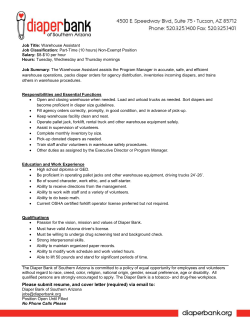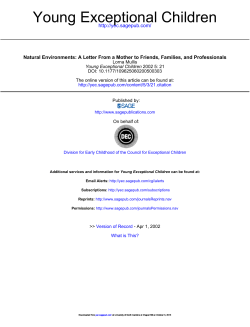
Central Jersey Pediatrics Highland Park Pediatrics Infants, Children & Adolescents Diaper Rash
Central Jersey Pediatrics Highland Park Pediatrics Infants, Children & Adolescents www.cjpediatrics.com Diaper Rash Diaper rash affects most babies. It can result in discomfort for your baby and worry for you. However, there are things you can do to try to make your baby feel better if it does occur. What is diaper rash? Diaper rash is a term used to describe any skin irritation in the diaper area. The known causes of diaper rash include wetness, not changing diapers often enough and a combination of urine and feces which irritate your baby’s skin. Other known causes include over cleansing with soaps, antibiotic usage and yeast and germ infections. What does it look like? The skin in the diaper area looks red and scaly, sometimes with scattered small bumps. You may notice small cracks, rubbed areas, thickening, or raw areas of the skin. The rash can be painful, causing fussiness and crying in your infant. If yeast infection occurs, the rash may become very red with well-outlined borders. Scattered bumps or pimples may appear in the skin near the borders. The rash may spread to cover the entire diaper area or beyond. What causes diaper rash? Diaper rash is caused by irritation of the skin. The most important factor is the length of time the skin stays wet and in contact with urine and stool (bowel movements). Other irritants can also contribute to a rash in the diaper area, such as Candida yeast. Warmth and wetness inside the diaper encourage germs to grow. Every baby’s skin is different; some babies just get diaper rash more often than others. Changing diapers frequently can help to prevent diaper rash. What are some possible complications of diaper rash? Serious complications are rare. However, diaper rash can be painful for your baby, interfering with sleep and play time Yeast infection may occur. Though this causes a red and well-outlined rash, it is usually easy to treat. Diaper rash may become severe, with very raw sores that may take a couple weeks to heal. Some babies have repeated problems with diaper rash. Even with treatment, the rash seems to keep coming back. What increases your baby’s risk of diaper rash? TRAVEL VACCINATION CENTER 1553 Ruth Road Suite 1, North Brunswick, NJ-08902 Dayton Professional Center, 401 Ridge Rd., Suite 2, Dayton, NJ 08810 Highland Park Pediatrics, 85 Raritan Ave, #410, Highland Park, NJ-08904 Tel: (732) 418- 1700 Fax: (732) 940-9700 07/07 1 Central Jersey Pediatrics Highland Park Pediatrics Infants, Children & Adolescents www.cjpediatrics.com Going too long between diaper changes. Using soaps or other products that irritate the skin. How you can try to prevent diaper rash? Avoid harsh soaps and don’t over cleanse. Harsh scrubbing after each diaper change may damage the outer protective layer of the skin. The problem gets worse as the skin becomes more irritated by wetness and bowel movements. You should avoid wipes with alcohol and perfumes, because these products can irritate your baby’s skin. Using water alone as a cleanser may be all that is necessary. Change diapers immediately after each bowel movement and when necessary to keep your baby dry and check the diaper about every hour. Wet skin is easily irritated by bowel movements. Wetness and harsh cleansing could damage and weaken the skin’s protective layer; this often leads to diaper rash. After cleaning gently pat the diaper area with a soft towel. You should also avoid using an electric hair dryer -this may cause “wind burn” on your baby’s sensitive skin. Apply a thin layer of ointment for protection against wetness and avoid perfumed lotions or powders with cornstarch that can irritate your baby’s skin. How can diaper rash be treated? Despite your best efforts, your baby still may get diaper rash. If this happens, there are steps yo u can take to help eliminate this rash. Make sure you change the diapers often and avoid air tight fastening (especially overnight). You can increase air circulation within the diaper by using large diapers and by loosely attaching diapers. You also can cut the elastic bands for a loose fit. Apply a cream, such as zinc oxide paste, which stays on longer. This protects the skin by sealing out moisture and the irritants within the bowel movements. With each diaper change, make sure the skin is clean and ensure that the layer of paste stays on your baby’s skin. Instead of wiping your baby’s skin clean, try using a running tap water. This is gentle on your baby’s skin and it is an easy way to rinse off bowel movements and urine in the diaper area. To make the jo b even easier, put your baby in a sink or tub for easy cleaning. Air Exposure- Leave your baby’s bottom exposed to the air as much as possible each day. Practical times are during naps or after bowel movements. Put a towel or diaper under your baby. Nighttime Care- At night use the new disposable diapers that are made with materials that lock wetness inside the diaper and away from the skin. Avoid plastic pants at night. Until the rash is better, awaken once during the night to change your baby’s diaper. Call us if the rash continues to worsen either on its own or during treatment. A yeast rash, a serious skin irritation, or an infection may require special medical treatment that we can recommend. Are cloth diapers or disposable diapers better for preventing diaper rash? TRAVEL VACCINATION CENTER 1553 Ruth Road Suite 1, North Brunswick, NJ-08902 Dayton Professional Center, 401 Ridge Rd., Suite 2, Dayton, NJ 08810 Highland Park Pediatrics, 85 Raritan Ave, #410, Highland Park, NJ-08904 Tel: (732) 418- 1700 Fax: (732) 940-9700 07/07 2 Central Jersey Pediatrics Highland Park Pediatrics Infants, Children & Adolescents www.cjpediatrics.com There are advantages and disadvantages to both cloth and disposable diapers. Because diaper rash often occurs when skin is wet and irritated, part of the diaper’s job is to keep the baby dry. Cloth and disposables are both effective as long as they are changed often. If you use cloth diaper use bleach to sterilize them. They are both equally effective. Additional information Many parents apply talcum powder to the diaper area during a change; however routine use of talcum powder is not recommended. If you do not use it, e sure to keep the powder away from your infant’s face because inhaling it could cause breathing problems. Also make sure that the container is far away from where your baby can reach it; this will keep your baby from accidentally inhaling the powder. Remember never leave your baby alone on the changing table or any other surface above the floor. Even a newborn can make a sudden turn and fall to the floor. If you change diapers often, your baby can usually avoid the pain and discomfort of diaper rash – and you can avoid worry. Talk with us if you have any questions or any concerns about diaper rash. Call us if: Diaper rash is not getting better after 3 days and is spreading beyond diaper area. Rash develops any big (more than 1” across) and has pimple, blisters, sores, crusts; see pus or bleeds. If child develops fever with rash. If lesion become bright red and tender to touch. If your child is acting very sick. If rash causes enough pain to interfere with sleeping. TRAVEL VACCINATION CENTER 1553 Ruth Road Suite 1, North Brunswick, NJ-08902 Dayton Professional Center, 401 Ridge Rd., Suite 2, Dayton, NJ 08810 Highland Park Pediatrics, 85 Raritan Ave, #410, Highland Park, NJ-08904 Tel: (732) 418- 1700 Fax: (732) 940-9700 07/07 3
© Copyright 2025












